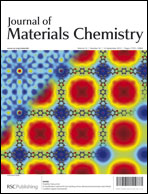Within metallic materials, alloys form the largest and richest family. We describe here a method for extending the properties of alloys even further, namely by incorporating organic compounds within bimetallic alloys, thus forming three-component organic–metallic composite-alloys of a novel type. Specifically, thionin and neutral red were entrapped in the following bimetallic systems: Ag–Au, Cu–Pt and Cu–Pd. This was achieved by zinc co-reduction of the two metal salts in the presence of the dye molecule to be entrapped. It was found that the two metals in each composite formed a bimetallic alloy, and that the entrapment yields were 95% and above in most composites. Using alloys as entrapping metallic matrices allows for the preparation of a wide variety of metal–organic composites of potential use in fields such as catalysis and sensing.
You have access to this article
 Please wait while we load your content...
Something went wrong. Try again?
Please wait while we load your content...
Something went wrong. Try again?


 Please wait while we load your content...
Please wait while we load your content...